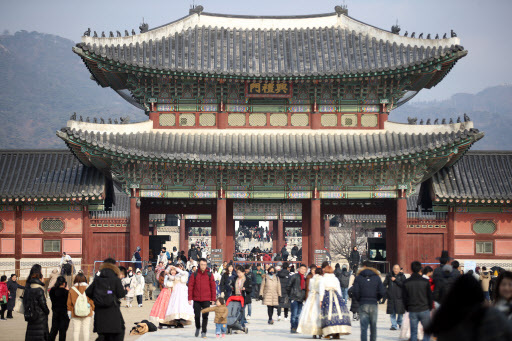 |
Gyeongbokgung (Yonhap) |
Although it is tempting to stay in bed late during the long Lunar New Year’s holiday, there will be diverse traditional cultural events and opportunities that people should not miss.
The Cultural Heritage Administration announced on Monday that four Joseon-era palaces in Seoul -- Gyeongbokgung, Changdeokgung, Deoksugung and Changgyeonggung -- will keep their doors open throughout the four-day holiday this year.
The four palaces will offer cultural experience programs for visitors. On Saturday, Gyeongbokgung will hand out Korean traditional paintings that signify good luck and well-being for one’s family. Deoksugung will allow people to experience a diverse range of traditional games.
This holiday is also a chance to freely look around the Jongmyo Shrine at the heart of Seoul, which is normally accessible by appointment only.
The Royal Tombs of the Joseon Dynasty, which are on the UNESCO World Heritage list, will also be open to the public.
Anyone can visit these sites free of charge, except for Huwon garden in Changdeokgung.
Many public museums will offer special cultural events to mark the Lunar New Year.
Music lovers can try the National Museum of Korea on Sunday. While it will be closed on Lunar New Year’s Day, which falls Saturday, it will open its doors on Sunday for an event featuring both traditional Korean and Western music.
Also on Sunday, the National Hangeul Museum will hold a concert titled “Sound Little Sound.” Traditional Korean musician Park Ji-ha and French musician Remi Klemensiewicz will play a number of traditional instruments during this show.
Outside Seoul, the national museums in Gyeongju, North Gyeongsang Province, and Jeonju, North Jeolla Province, as well as the one in Daegu, will offer traditional Korean cooking classes and traditional games.
Some museums have prepared little gifts for visitors to take home, such as souvenirs for visitors wearing hanbok, or Korean traditional attire. They are available from the national museums in Gwangju, as well as in Jeonju, North Jeolla Province, and Gongju, South Chungcheong Province. Everyone who visits the Jinju National Museum will receive a rat-shaped coin bank in celebration of the Year of the White Rat.
By Song Seung-hyun (
ssh@heraldcorp.com)






![[Herald Interview] 'Trump will use tariffs as first line of defense for American manufacturing'](http://res.heraldm.com/phpwas/restmb_idxmake.php?idx=644&simg=/content/image/2024/11/26/20241126050017_0.jpg)
![[Health and care] Getting cancer young: Why cancer isn’t just an older person’s battle](http://res.heraldm.com/phpwas/restmb_idxmake.php?idx=644&simg=/content/image/2024/11/26/20241126050043_0.jpg)
